The Be Quiet! Pure Rock 2 FX CPU Cooler Review: For Quiet Contemplation
by E. Fylladitakis on August 8, 2023 8:00 AM EST- Posted in
- Cases/Cooling/PSUs
- be quiet!
- CPU cooler
- ARGB
Testing Results, Maximum Fan Speed
To begin with, we are having a look at the Be Quiet! Pure Rock 2 FX with its stock 120 mm fan running at its maximum speed.
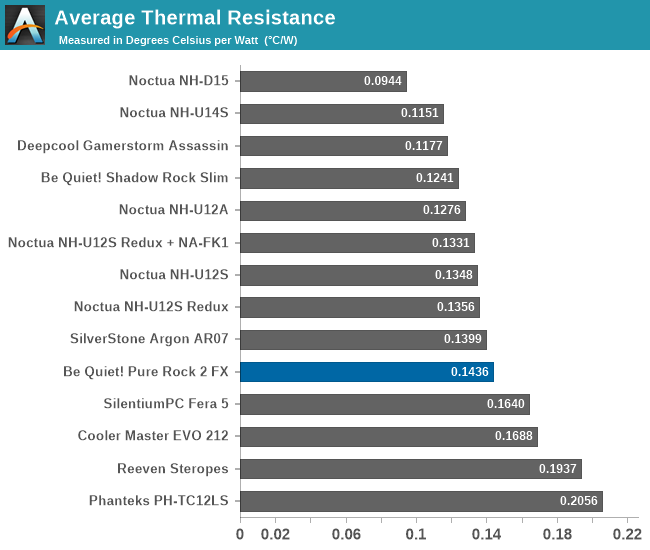

| Core Temperature, Constant Thermal Load (Max Fan Speed) |
Overall, the performance figures we received from the Pure Rock 2 FX were not far from other similarly-sized products. With an average thermal resistance of 0.1436 °C/W, the Pure Rock 2 FX lands very close to most single-array 120 mm fan tower coolers, such as the Noctua U12A and the Cooler Master EVO 212. It has a relatively steady thermal profile, with the thermal resistance reaching its optimum value with a load of exactly 150 Watts, the design power of this cooler.
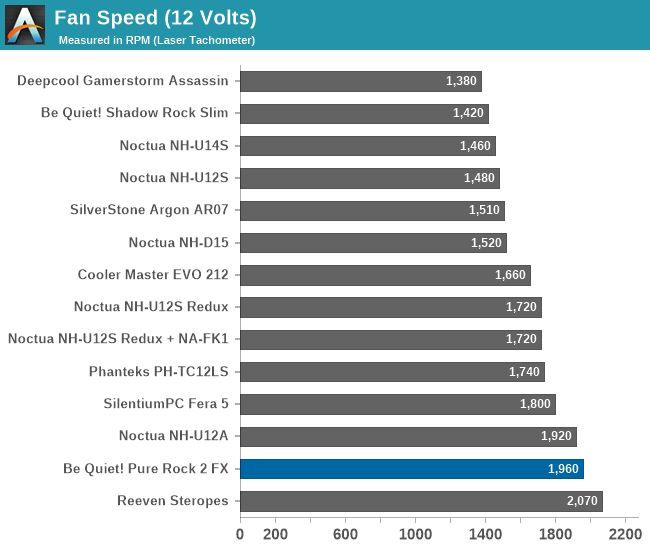
Be Quiet!’s main focus is quiet operation, and the Light Wings fan does a fairly good job at it. Although the 37.1 dB(A) that we record with the fan running at its maximum speed is definitely not absolutely quiet, it is a very low figure for a fan running at 2000 RPM. The Light Wings fan is audible at maximum speed but the noise pressure level ought to be tolerable for the vast majority of users, even in a very quiet environment.
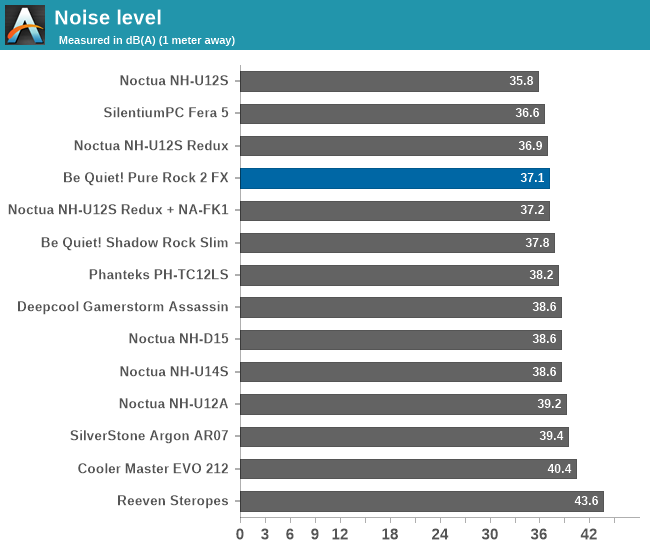
Testing Results, Low Fan Speed
In this test we are switching things up a bit, taking a look at the cooler’s performance with the Light Wings fan taken down to half speed.


| Core Temperature, Constant Thermal Load (Low Fan Speed) |
The reduction of the fan’s speed to 1000 RPM naturally has a negative impact on the thermal performance of the Pure Rock 2 FX cooler, yet that impact is lesser than we anticipated. The average thermal resistance of 0.1812 °C/W is now better than that of most similarly sized CPU coolers, with only the dual fan Noctua NH-U12A and NH-U12S + NA-FK1 coolers managing to outperform it. What gives the Pure Rock 2 FX this performance edge is the speed of the Light Wings fan, which is higher than most other coolers in this test.
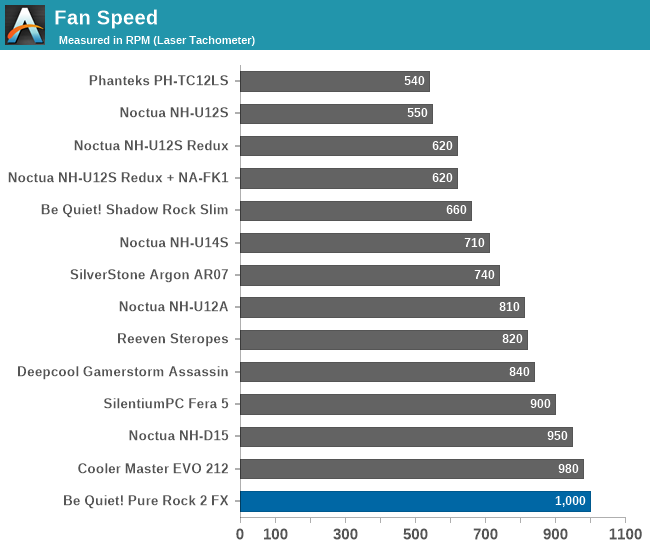
Reducing the speed of the Light Wings 120 mm fan down to 1000 RPM makes the Pure Rock 2 FX cooler practically inaudible. With a sound pressure reading of 32.3 dB(A) at one meter, it should be nearly impossible to notice the cooler unless you're in a dead-silent room.
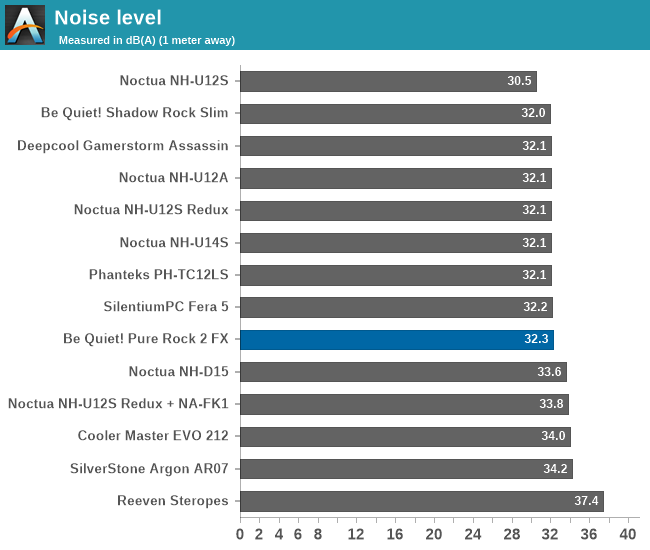
Thermal Resistance VS Sound Pressure Level
During our thermal resistance vs. sound pressure level test, we maintain a steady 100W thermal load and assess the overall performance of the coolers by taking multiple temperatures and sound pressure level readings within the operating range of the stock cooling fans. The result is a graph that depicts the absolute thermal resistance of the cooler in comparison to the noise generated. For both the sound pressure level and absolute thermal resistance readings, lower figures are better.
This chart reveals the standing of the Pure Rock 2 FX cooler against its direct competition. It delivers about the same thermal performance as the Noctua NH-U12S and the SilverStone Argon AR07, yet at either a louder or a quieter noise level respectively. Other similarly sized coolers seem to have lower thermal performance over the same noise levels.











32 Comments
View All Comments
meacupla - Wednesday, August 9, 2023 - link
Direct touch heatpipes have their downsides.The heatpipes need to make even contact over all the hot spots to be most effective. On Anandtech's test bench, this downside is unlikely to show up. This is more likely to happen on AMD chiplet CPUs, where the hot-spot is off-center.mode_13h - Friday, August 11, 2023 - link
If AMD had brought their vapor chamber IHS to market, that should virtually eliminate hotspots, making direct-touch heatpipes ideal. It'd be just like we see in high-end GPUs that integrate vapor chambers, and we all know how much heat those can dissipate!charlesg - Wednesday, August 9, 2023 - link
I have a Noctua on my 5950X. Very pleased with it.Their customer service is out of this world, too!
At one point I wanted to add more memory to my system, only to find out the pipes from the cooler were in the way. So I emailed them.
They sent me a new bracket that would allow me to have the pipes a different direction. From Germany. Complete with shipping notification in German. For free!!!
Samus - Thursday, August 10, 2023 - link
I've had my D15 since ~2015 and recently had to have them send me the bracket for socket 1700. They did so 2-day mail for free. I still have the original 120mm fans on it too. I cleaned them when I rebuilt the PC with the new board\CPU and they still work perfect. The D15 and my PCP&C power supply are the oldest components (my PSU is even older - from 2008) and they still work.Threska - Tuesday, August 8, 2023 - link
"Modern, high-end CPUs will essentially will turbo as hard and as long as their cooling systems will allow, making sustaining those clockspeeds critical to getting the best performance out of a system."Increase chances of a crash as well. Some being the silicon lottery.
mode_13h - Tuesday, August 8, 2023 - link
One benefit you supposedly get from buying Xeon CPUs is that they are qualified with extra margins, to ensure stability.Since I can no longer afford any of the Xeons or the platform they require, I will try to get by with running a mainstream Core-series CPU on a restricted power budget. And ECC RAM, of course.
Sivar - Wednesday, August 9, 2023 - link
You can always use an AMD CPU. In this generation, their CPUs use half the power. Intel is now playing the old AMD game of overclocking their own CPUs to ad absurdum just to keep up with their competitor.blzd - Friday, August 18, 2023 - link
DDR5 has built in ECC on consumer level I believe.tygrus - Monday, August 21, 2023 - link
Standard DDR5 has ECC on chip protecting from random 1bit per byte flips while data is at rest. It doesn't cover the signal integrity between CPU & RAM.Reg ECC DDR5 for servers provides the extra protection of data in transit in addition to protecting data at rest.
mode_13h - Thursday, August 24, 2023 - link
@tygrus, you mention "Reg ECC DDR5", but it's also available unbuffered.The main downside of ECC DDR5 DIMMs is that you now need 25% more DRAM chips than non-ECC, due to the bifurcation of the DIMMs into 2 32-bit subchannels, yet each still having 8 bits of ECC.